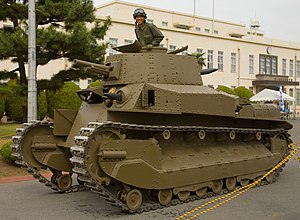
Back نوع 89 أي-غو Arabic Type 89 I-Go BS Tipus 89 Yi-Go Catalan Typ 89 I-gó Czech Typ 89 I-Gō German Tipo 89 I-Go Spanish Tüüp 89 I-Go Estonian Type 89 I-Go Finnish Type 89 I-Go French 89-es típusú harckocsi Hungarian
| Type 89 I-Go (Chi-Ro) | |
|---|---|
 A restored Type 89 I-Go at Tsuchiura JGSDF Base open day | |
| Type | Medium tank |
| Place of origin | Empire of Japan |
| Production history | |
| Designed | 1928 |
| Unit cost | Model Otsu: 97,000 yen ($26,064 USD) in August 1939, excluding armaments[1][2] |
| No. built | 404[3] |
| Specifications | |
| Mass | 12.79 metric tons (14.10 short tons) |
| Length | 5.73 m (18 ft 10 in) |
| Width | 2.15 m (7 ft 1 in) |
| Height | 2.56 m (8 ft 5 in) |
| Crew | 4 |
| Armor | 6 to 17 mm (0.24–0.67 in) |
Main armament | 57 mm Type 90 gun 100 rounds[4] |
Secondary armament | 2 x 6.5 mm Type 91 machine gun (hull, turret rear) 2,745 rounds[4] |
| Engine | Mitsubishi A6120VD air-cooled inline 6-cylinder diesel 120 hp (90 kW)/ 1800 rpm 14,300cc |
| Suspension | leaf spring |
Operational range | 170 km (110 mi) |
| Maximum speed | 26 km/h (16 mph) |
The Type 89 medium tank I-Go (八九式中戦車 イ号, Hachikyū-shiki chū-sensha I-gō) is a medium tank used by the Imperial Japanese Army from 1932 to 1942 in combat operations of the Second Sino-Japanese War, at Khalkhin Gol against the Soviet Union, and in the Second World War. The Type 89B model was the world's first mass-produced diesel engine tank.[5] The tank was armed with a short-barrel 57 mm cannon for knocking out pillboxes and masonry fortifications, and proved effective in campaigns in Manchuria and China, as the Chinese National Revolutionary Army had only three tank battalions to oppose them, which consisted primarily of Vickers export models, German Panzer Is, and Italian CV33 tankettes.[6] The Type 89 was a 1920s design medium tank, built to support the infantry, and thus lacked the armor or armament of 1940s generation Allied armor; it was regarded as obsolete by the time of the 1939 battles of Khalkhin Gol, against the Soviet Union.[7] The code designation "I-Go" comes from the katakana letter [イ] for "first" and the kanji [号] for "number". The designation is also transliterated Chi-Ro and sometimes "Yi-Go".[8][9]
- ^ "兵器臨時定価、予価、表送付の件 Military catalogue of the Japanese military". National Archives of Japan. Ministry of the Army.
- ^ "Banking and Monetary Statistics, 1914-1941, Part I". Federal Reserve Bank of St. Louis. Board of Governors of the Federal Reserve System (U.S.). January 1943 [1943].
- ^ Zaloga 2007, pp. 6, 10.
- ^ a b Tomczyk 2002, p. 28.
- ^ Zaloga 2007, p. 6.
- ^ Zaloga 2007, p. 12.
- ^ Foss 2003a.
- ^ Tomczyk 2002, p. 17.
- ^ Zaloga 2007, p. 5.
© MMXXIII Rich X Search. We shall prevail. All rights reserved. Rich X Search